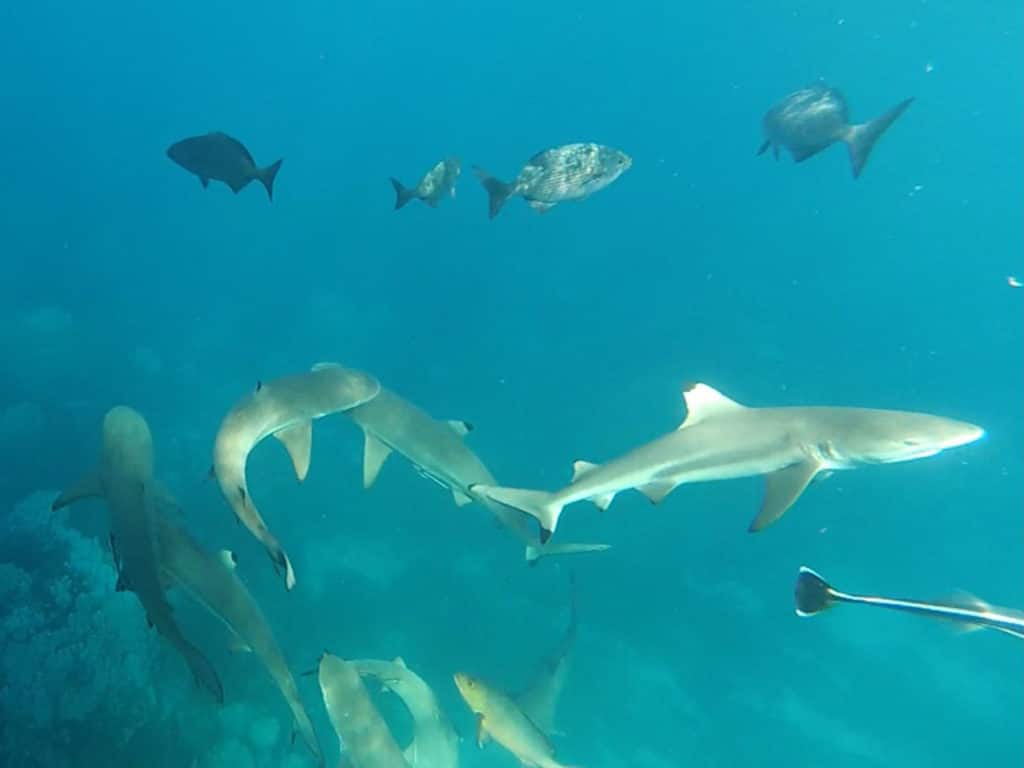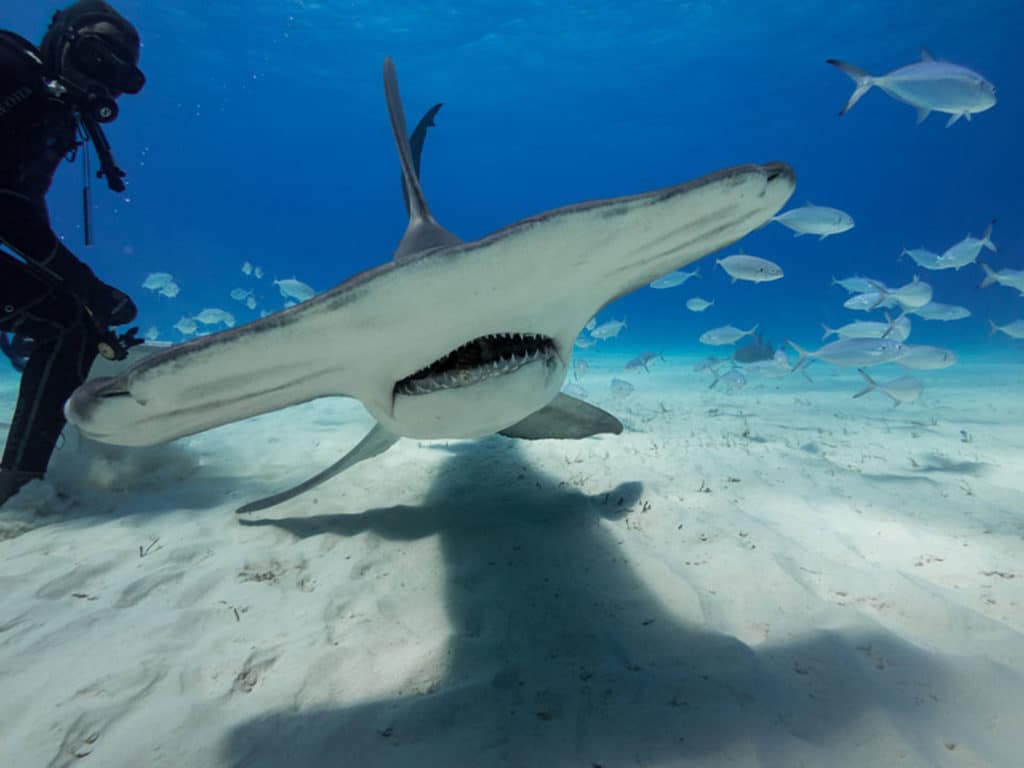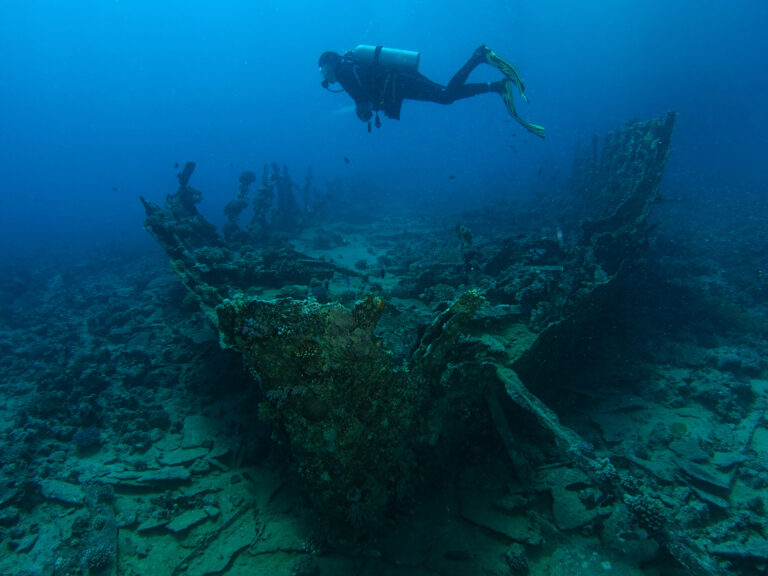
Fakarava atoll in the Tuamotus, French Polynesia, is home to some of the world’s best shark diving. In 2010, my family and I floated in the lagoon’s current, holding lines attached to our dingy as we drifted over variegated coral and colorful reef fish. I tried to enjoy it but my heart pounded when I saw the scores of sharks in the water below us. Together we rode the roller coaster of current flowing into Fakarava and I wondered: are Jamie and the kids having trouble enjoying it, too? It was hard not to think of my young children— and myself and Jamie— as thrashing, tasty morsels.
The fear isn’t rational, but it’s real. It also fades, given the right combination of knowledge and experience. So much has changed since that swim in Fakarava. We know we’re a far bigger threat to sharks than they are to us. But because sharing the water with sharks is something cruisers might worry about, here’s some insight.

Nervous is normal
Jamie and I joke that we are tainted by growing up in the Jaws generation, where the villain is a massive great white shark that hunts and kills humans. Pure fiction. Jamie learned to sail in the very waters where Jaws is set. That didn’t help. Although the book and subsequent film made Peter Benchley a millionaire, he regretted writing Jaws. “No one appreciates how vulnerable (sharks) are, to destruction,” Benchley said. The Discovery Channel’s Shark Week and other media hype around sharks doesn’t help; neither do a shark’s massive teeth and dull eyes. When all of these factors add up, of course we’re nervous about sharing the water with sharks.
Getting over the fear
Try to internalize the fact they’re not after you for a meal (I feel you, fellow Jaws generation). Sharks, in general, don’t actually care about you. They may have a passing interest, but they’re rarely looking at you and considering a taste test. Rather, when sharks see humans in the water they’re trying figure out, what’s this thing in my space?
Making positive associations with the presence of sharks might help. Our first year and a half of cruising was largely in Mexico; we saw exactly one live shark the entire time (we saw several depressing piles of desiccated juvenile hammerhead heads on the beach, though). In French Polynesia, once we got over our fear of the unknown, our kids quickly became conditioned to the idea that it’s actually a bad sign if you don’t see any sharks swimming on a coral reef. If the top-level predator is missing, that is a sign that the reef isn’t healthy. Shark sightings became the welcome sign that all was well with the reef.
I asked Andy and Laura Corbe—cruisers, shark experts and ocean advocates— for input. “The more time you spend in the water with sharks, in their environment and on their terms, the more you see that everything you thought you knew about sharks is wrong,” Laura said.
Be smart about sharks
Getting over the fear of sharks includes educating yourself and others about when you want to avoid their space.
Beware of fish blood in the water. If there’s fishing activity nearby, know that that may attract sharks with the siren call of fresh dinner and be mindful or avoid the adjacent water altogether. Cleaning fish off the back of your boat can train sharks to come looking for food. There are a few docks in the Bahamas I wouldn’t swim near (I’m picturing Staniel Cay in particular, as sport fishermen have trained those sharks to hang around for meals). There’s no truth to menstrual blood attracting sharks, but fish blood is a dinner bell.

Spearfish with caution. In the South Pacific, we learned that in a few places getting off a single shot with a spear gun attracted sharks that were, well, more curious than we liked. Especially if that shot nailed a fish that was vibrating all over the place or bleeding in the water. We’d take one shot and then move on to a different coral head or different part of the atoll. This isn’t universal, but local; local knowledge on shark presence and activity is always a great place to start.
Murky water is best avoided. Where there are shark bites (do we have to call them shark attacks?) it’s likely a case of “Oops, you’re not what I thought.” Well, most of the time we’re in pretty nice water. But that’s also why it’s good to avoid low light situations and why you might hear people talk about avoiding swimming at “shark thirty”— those dusky hours when light is low.

Make eye contact. “The most important thing we try to impart is to always maintain eye contact with a curious shark,” Andy told us. “Never turn your back to one that is swimming towards you.” I didn’t realize this was a factor until checking in with the Corbes. “Pretty much in every hunt, as soon as eye contact is established the game is up, as the prey is generally more maneuverable than the shark,” he said. Most of us don’t want to be close enough to have to think about making eye contact through our masks, but this is something I like knowing about.
Stay mellow. “Relax!” Laura told us. “The shark is not there to eat you, they don’t actually need to eat a lot to sustain themselves and chances are the shark’s not even hungry. So be calm, avoid jerky movements and avoid sounding like a tasty, dying fish!” This was hard for me, for a long time, and will probably take some adjustment period once we’re able to swim in places with sharks again.
Know your sharks. Try to learn about different species, their different behaviors and the relative risk each one brings. (See the resources at the end of this article). Learn how to identify normal activity and normal body movement for a shark, and know what appears to be agitation. If you see a shark moving about with jerky movements instead of smooth movements, or arching their back and popping their gills, these are all signs it’s time to move away.
Our typical experience
What can cruisers expect? You may rarely see sharks (Mexico) or see them on almost every snorkel (French Polynesia). It depends on where you go and how much time you spend in the water, and if you’re paying attention.
Most of the sharks we see are either harmless (such as nurse sharks, the species you’re most likely to encounter in the Bahamas), or uninterested in divers (reef sharks happily going about their fishy business).

We always try to pay attention to what’s around us. If we see a shark, we let folks around us know we’ve spotted one, using a sign— we put one hand on top of our heads like a fin. Then, we watch! The first pass, the shark’s just moseying through. Second pass, well, they’re kind of curious. If they make a third pass and keep getting closer, we figure it’s time to change locales or just get out of the water for a while. If there’s any behavior that signals aggression, we are out the water. Why tempt fate?
Buddy systems are always good. When I cleaned the bottom of Totem in “sharky” Salomon Atoll, in the Chagos Archipelago, my daughter Mairen was my fish spotter. I could focus on getting muck off the bottom, which the reef fish loved. She could make sure that there was nothing toothier than the reef fish taking an interest in my activity.
We have been in instances where we’ve experienced aggressive shark behavior and, yes, it’s unnerving. The most serious moments have involved a spear gun and a wriggling fish. One time we witnessed aggressive shark behavior in an anchorage where sharks had probably been conditioned to look for a meal because of fish detritus. We got out of the water quickly and went elsewhere.
Laura Corbe cautioned that people new to sharing the water with sharks should remember that sharks are apex predators that can and do bite. “You need to be on your game with your head on a swivel constantly. If you’re not comfortable redirecting a shark, then don’t get in the water with big sharks.” This gave me a giggle and a smile, because Laura has reveled in swimming with some very large sharks. Like most cruisers, I’m pretty good just keeping company with the puppies (the name we call fat, sometimes sassy black-tip reef sharks) and probably wouldn’t stick around long with the massive, oceanic white tips Laura’s seeks to share the water with.

About protective devices
Skip these. There are devices meant to act as deterrents. Some do work, but the wearable ones a cruiser might want to use don’t work well and are quite expensive. The Save Our Seas Foundation did a great writeup on the options, and why they largely don’t work. According to Save Our Seas, the wearable deterrents were shown to have limited to no measurable effect on shark behavior. Read about their study here.
Resources
What You Should Know About Sharks is a book by free diver / conservationist / scientist Ocean Ramsey. It’s at the top of my book list. It includes information on how to avoid and deter sharks, and how to interact with sharks, along with information on how to react to adverse interactions. For a quick fix, Ocean’s Instagram is rich with images and information for safely sharing the water with sharks. Another great resource is The Shark Handbook: Essential Guide for Understanding Sharks of the World
And finally, teach your kids about underwater life. We protect what we know! Here’s a roundup of books to help inform kids on marine life.
National Geographic Little Kids First Big Book of the Ocean
The Usborne Internet-Linked First Encyclopedia of Seas and Oceans
1001 Things to Spot in the Sea
Golden Guide book of Whales, Dolphins, and Other Marine Mammals








